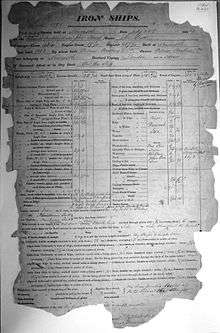John Bowes (steamship)
John Bowes, built on the River Tyne in England in 1852, was one of the first steam colliers. She traded for over 81 years before sinking in a storm off Spain.
 Steamship John Bowes model in the Collection of Tyne & Wear Archives and Museum Service South Shields Museum (display). | |
| History | |
|---|---|
| Name: | John Bowes |
| Owner: | Charles Mark Palmer, Newcastle[1] |
| Port of registry: | United Kingdom |
| Builder: | Palmer Brothers & Co, Jarrow |
| Yard number: | 2 |
| Launched: | 30 June 1852[2] |
| Christened: | 30 June 1852 |
| Completed: | 22 July 1852 |
| Maiden voyage: | 27 July 1852 |
| Out of service: | 12 October 1933 |
| Refit: | 1853(?), 1864 and 1883 |
| Homeport: | Newcastle[1] |
| Identification: | Official number 26276[1] |
| Fate: | Foundered |
| General characteristics | |
| Type: | Iron hulled steam screw & sail collier |
| Tonnage: | 437 GRT[2] |
| Length: | 149.0 ft (45.4 m)[2] |
| Beam: | 25.7 ft (7.8 m)[2] |
| Depth of hold: | 15.6 ft (4.8 m)[2] |
| Propulsion: | Steam, two cylinder by Robert Stephenson[2] |
| Sail plan: | Topsail schooner |
| Speed: | 9 knots (17 km/h; 10 mph) |
Development
Owing to her success, John Bowes is often said to be the first steam collier.[3][4][5][6] That is not quite true. Bedlington of 1841 could have that honour but she only worked locally (albeit in the open sea), she carried the coal in railway wagons (she was not a bulk carrier but a type of ferry) and she was wrecked in 1846.[7]
The entrepreneur behind John Bowes′ design was Charles Mark Palmer. She was the second vessel from his new Jarrow shipyard, founded with his brother George, which would build over a thousand ships. The vessel's key novelties were the iron hull, water ballast and steam screw propulsion, despite which an auxiliary sailing rig was also fitted.


Career
The steamer was launched on 30 June 1852 and named in honour of John Bowles, mine owner, business partner of Charles Palmer and the then High Sheriff of Durham.[8] Her working life started on 27 July, with coal from the Tyne to London. Within the week, she had done the work of two collier brigs for a month and a stream of similar ships followed. Initially, the design of the ballast tanks proved problematical, as they could not be kept watertight, and Palmer tried a number of solutions before settling on longitudinal iron tanks beneath each hold designed by John McIntyre, manager of the Jarrow shipyard from 1853.[2][9] During a voyage from Rosedale, Yorkshire to the River Tyne, she ran aground on the Insand, in the North Sea off the coast of County Durham, England, on 16 July 1860.[10]
Despite her mishap, this first steam collier had a long and prosperous life. She was re-engined in 1864 and 1883.[11] She ran aground on Heligoland on 9 June 1864. She was refloated but had to be beached. She was repaired and resumed her voyage to Hamburg. [12][13] In 1873, John Bowes was sold to Benjamin Barnett and registered at London,[14] and in 1896, to James Mackenzie ('John Bowes' Steamship Co Ltd) of Dublin. In 1898, she left the British flag on sale to Scandinavian owners as Spec and later Transit. In 1908, she was sold to Spain, where she traded for a further twenty five years as Carolina, Valentin Fierro and lastly Villa Selgas.[15]
Loss
Whilst owned by Federico Fierro of San Sebastián,[15] and on a voyage from Bilbao to San Esteban de Pravia, with an iron ore cargo, Villa Selgas encountered a storm in the Bay of Biscay, began leaking and foundered off Ribadesella, on 12 October 1933.[16][17][18] All twelve crew abandoned ship and were rescued by the fishing vessel Aurora which landed them at Ribadesella.[18]
References
- Mercantile Navy List. London: Board of Trade. 1870. p. 204. Retrieved 21 May 2020.
- Clarke, Joe F (1997). Building Ships on the North East Coast. Whitley Bay: Bewick Press. pp. 120–121, 134–5. ISBN 1-898880-04-2.
- http://www.wrecksite.eu/wreck.aspx?188671
- http://www.chroniclelive.co.uk/news/north-east-news/collier-who-steamed-north-legend-1619012
- http://www.tynetugs.co.uk/Palmer.html
- http://www.englandsnortheast.co.uk/Shipbuilding.html
- The Steam Colliers Fleets by Messrs MacRae & Waine, Waine Research 1990 pages 11–13.
- "Launch of a Steam Collier on the Tyne". Newcastle Guardian (335). The British Newspaper Archive (subscription). 3 July 1852. p. 5. Retrieved 22 May 2020.
- "North of England" (PDF). The Engineer: 239. 2 March 1900. Retrieved 26 April 2013.
- "Marine Intelligence". Newcastle Courant (9682). Newcastle upon Tyne. 20 July 1860.
- The Steam Collier Fleets by Messrs MacRae & Waine, Waine Research 1990 page 13
- "Mercantile Ship News". The Standard (12432). London. 14 June 1864. p. 7.
- "Marine Intelligence". Newcastle Courant (9886). Newcastle upon Tyne. 17 June 1864.
- Mercantile Navy List. London: Board of Trade. 1880. p. 69.
- Register of Ships (PDF). London: Lloyd's Register. 1933. Retrieved 26 April 2013.
- "Very old Spanish steamer lost". The Times (46575). London. 14 October 1933. col G, p. 4.
- Returns of Ships Totally Lost, Condemned &c – 1933, 4th Quarter. London: Lloyd's Register of Shipping. 1934. p. 5.
- "Naufragio del Vapor "Villa Selgas"". Diario de la Mañana (in Spanish). Oviedo. 13 October 1933. Archived from the original on 21 May 2020. Retrieved 21 May 2020.